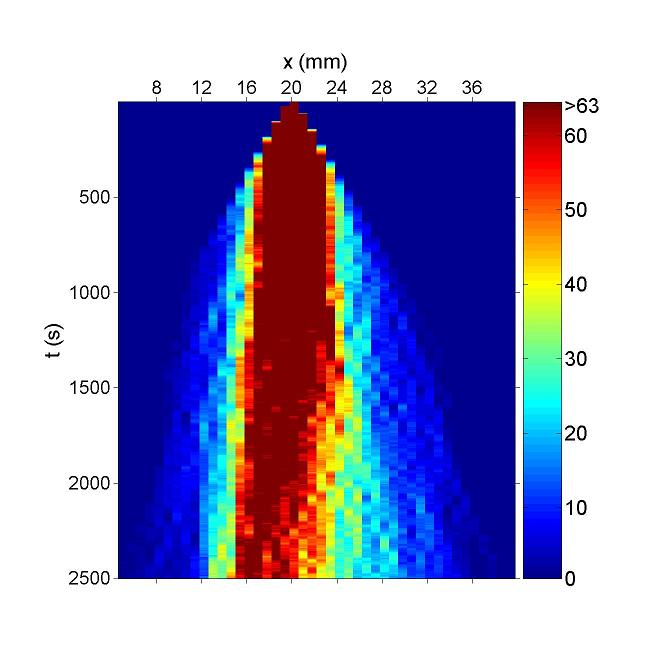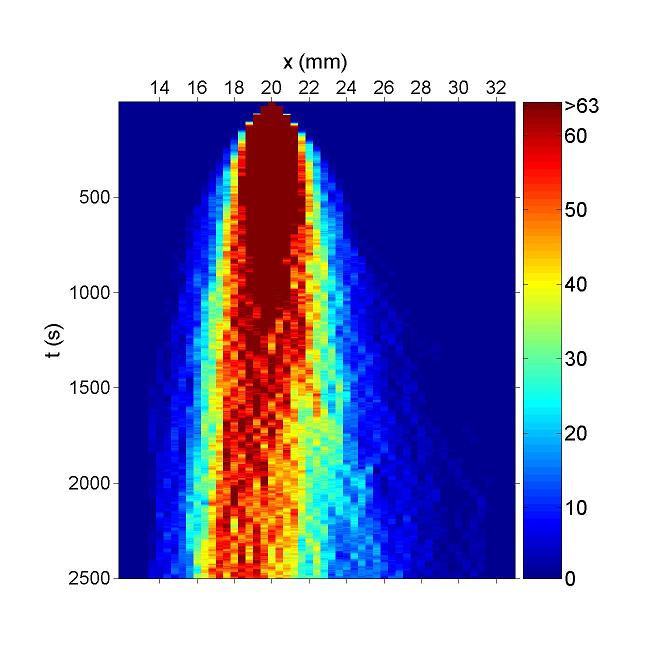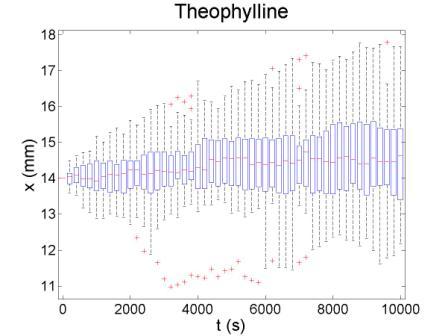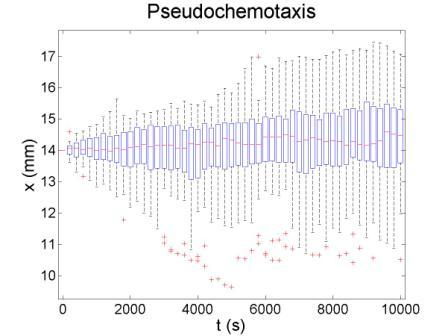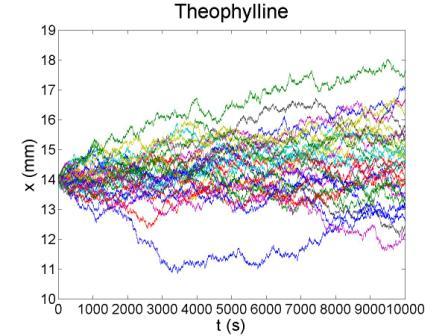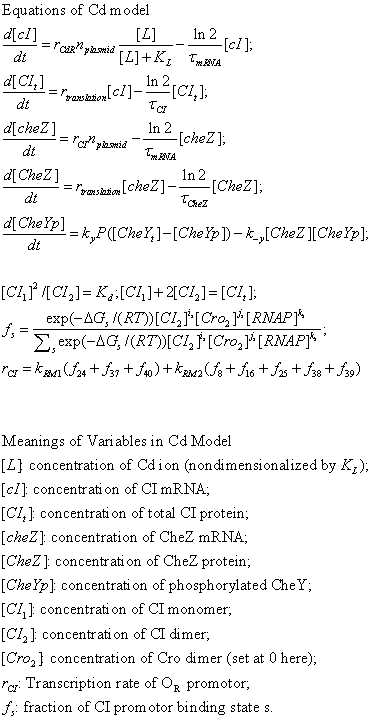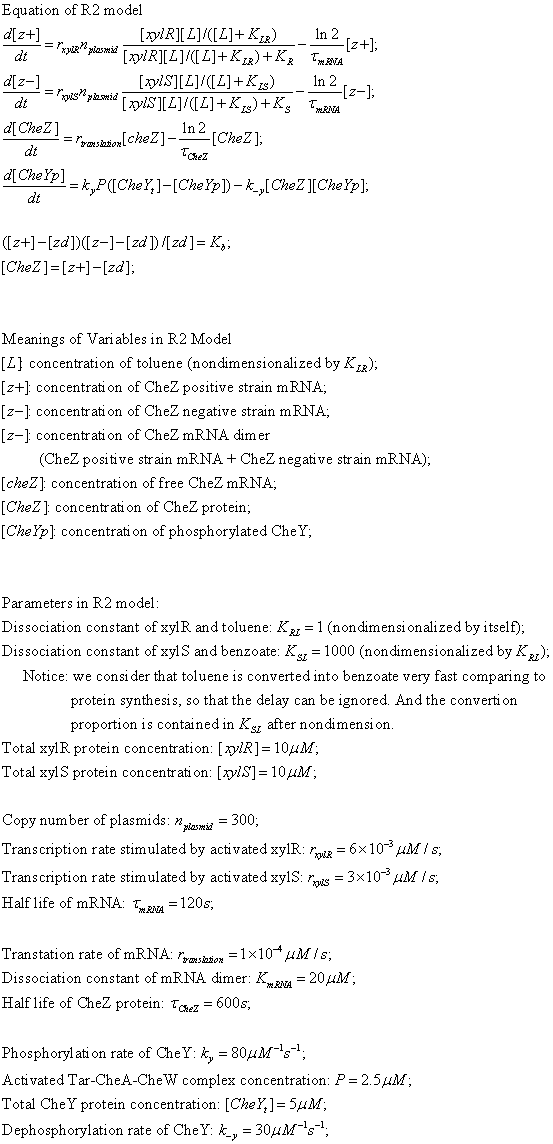Chemotaxis Modeling
From 2008.igem.org
(→Equations and Parameters) |
(→Software Platform) |
||
| (28 intermediate revisions not shown) | |||
| Line 1: | Line 1: | ||
<!--- The Mission, Experiments ---> | <!--- The Mission, Experiments ---> | ||
| - | [[image: | + | [[image:331.jpeg|center|]] |
{| style="color:#1b2c8a;background-color:#0c6;" cellpadding="3" cellspacing="1" border="1" bordercolor="#fff" width="100%" align="center" | {| style="color:#1b2c8a;background-color:#0c6;" cellpadding="3" cellspacing="1" border="1" bordercolor="#fff" width="100%" align="center" | ||
!align="center"|[[Team:Tsinghua|HOME]] | !align="center"|[[Team:Tsinghua|HOME]] | ||
| Line 13: | Line 13: | ||
| - | == | + | == Software Platform == |
| - | + | ||
| + | |||
| + | We build a software plat for simulating bacteria movement on plat in the first step of our modeling works. This platform enables investigators to simulate bacterium movement, track their trace and analyze chemotaxis effects. Further more, this platform support distribution calculatioin on cluster computers. All these facilitate pathway design and test. Our researches about each subprojects in Project 1 are based on these tools. | ||
| - | |||
Our software platform is made up by three main modules: concentration field, motor and pathway. | Our software platform is made up by three main modules: concentration field, motor and pathway. | ||
| - | Concentration field module: the concentration of target chemical in each location. The shape of the field can be set in each simulation in order to fit our need. In most of our experiments, we use mountain-shaped field (L=L_0*exp(-(x/r)^2)). | + | ''Concentration field module'': the concentration of target chemical in each location. The shape of the field can be set in each simulation in order to fit our need. In most of our experiments, we use mountain-shaped field (L=L_0*exp(-(x/r)^2)). |
| - | Motor module: A Markov chain with state 0 (tumble) and 1 (run) to represent the working state of molecular motor impelling E. coli. The state of molecular motor is approximated to not change in a small time scale. The state in the next time scale is determined by current state and CheY-p concentration. | + | ''Motor module'': A Markov chain with state 0 (tumble) and 1 (run) to represent the working state of molecular motor impelling E. coli. The state of molecular motor is approximated to not change in a small time scale. The state in the next time scale is determined by current state and CheY-p concentration. |
| - | Pathway module: A set of differential equation expressing the dynamic relationship between ligand and CheY-p concentration. Users can simulate an entirely new chemotaxis pathway by merely modify this module. This helps researchers focus on pathway design without considering other parts of the model. | + | ''Pathway module'': A set of differential equation expressing the dynamic relationship between ligand and CheY-p concentration. Users can simulate an entirely new chemotaxis pathway by merely modify this module. This helps researchers focus on pathway design without considering other parts of the model. |
The program we used simulates the movement of bacteria on plate, so the position of E. coli is described by a 2 dimensional vector. In each simulation, all the bacteria start the same initiation position but their directions are randomly selected. The concentrations of molecule in the pathway are set at equilibrium. At the end of each times scale, the concentration of CheY-p is calculated and this value influences motor state in the next time scale. | The program we used simulates the movement of bacteria on plate, so the position of E. coli is described by a 2 dimensional vector. In each simulation, all the bacteria start the same initiation position but their directions are randomly selected. The concentrations of molecule in the pathway are set at equilibrium. At the end of each times scale, the concentration of CheY-p is calculated and this value influences motor state in the next time scale. | ||
Code of the software platform can be download here: | Code of the software platform can be download here: | ||
| - | [[Image:main.rar]][[ | + | [[Image:main.rar]] http://www.bioinfo.tsinghua.edu.cn/luojunjie/soft.zip |
| + | |||
| + | [[Content of the package...]] | ||
---- | ---- | ||
| + | '''Future Plan''' | ||
| + | We plan to develop the next version of this software, made some modification of the original version as following: | ||
| - | + | 1 Expand the concentration field from plane to three dimensions; | |
| - | + | 2 Support the visual user interface; | |
| - | + | 3 Provide some useful plotting tools to present the particle motion, analyze result and so on; | |
| + | 4 Support multi-ligand concentration field; | ||
| - | + | 5 Provide an interface of automation toolbox; | |
| - | + | ||
| - | + | ||
| - | + | ||
| + | 6 Improve the efficiency. | ||
---- | ---- | ||
| - | ''' | + | == Results and Discussion== |
| - | + | '''CdLocalizer''' | |
| - | + | ||
| - | + | ||
| - | + | ||
| - | + | ||
[[Image:Cd1.jpg]] | [[Image:Cd1.jpg]] | ||
| - | Figure. Simulation result of Bacteria movement of CdLocalizer Project. Chemotaxis behaviors of 1000 bacteria are simulated in a mountain-shaped concentration field. The peak value of the concentration field is 10 and size constant of it is 10 mm. Horizontal axis is x coordinate of bacteria while vertical axis is time. The change in color illustrates the density of bacteria.Deep | + | Figure. Simulation result of Bacteria movement of CdLocalizer Project. Chemotaxis behaviors of 1000 bacteria are simulated in a mountain-shaped concentration field. The peak value of the concentration field is 10 and size constant of it is 10 mm. Horizontal axis is x coordinate of bacteria while vertical axis is time. The change in color illustrates the density of bacteria.Deep Red is the most while blue is none. We can find that in this simulation, bacteria move to the place with higher concentration. And their motilities are suppressed after reaching a certain concentration. This fits to our demand. However, because we covert GCS to MCS via pseudo chemotaxis strategy, diffusion interferences bacteria chemotaxis behaviors. Not all bacteria will localized at certain concentration. |
| - | Red is the most while blue is none. | + | |
| - | concentration | + | |
---- | ---- | ||
| + | '''DualReceptor''' | ||
| + | |||
[[Image:R2.jpg]] | [[Image:R2.jpg]] | ||
| - | Figure. Simulation result of Bacteria movement of DualReceptor Project. Chemotaxis behaviors of 1000 bacteria are simulated in a mountain-shaped concentration field. The peak value of the concentration field is 20 and size constant of it is 14 mm. Horizontal axis is x coordinate of bacteria while vertical axis is time. The change in color illustrates the density of bacteria.Deep | + | Figure. Simulation result of Bacteria movement of DualReceptor Project. Chemotaxis behaviors of 1000 bacteria are simulated in a mountain-shaped concentration field. The peak value of the concentration field is 20 and size constant of it is 14 mm. Horizontal axis is x coordinate of bacteria while vertical axis is time. The change in color illustrates the density of bacteria.Deep red is the most while blue is none.We can find that in this simulation, bacteria move to the place with higher concentration. And their motilities are suppressed after reaching a certain concentration. This fits to our demand. However, because we covert GCS to MCS via pseudo chemotaxis strategy, diffusion interferences bacteria chemotaxis behaviors. Not all bacteria will localized at certain concentration. |
| - | + | ||
| - | concentration | + | |
| - | + | ||
---- | ---- | ||
| - | + | '''TheoRiboSwitch''' | |
| - | + | ||
| Line 89: | Line 85: | ||
---- | ---- | ||
| - | Our following research focus on how to find a design principles of chemotaxis pathway. Actually, functions of chemotaxis pathway involve two aspects: signal transduction and signal conversion. It not only bring ligand concentration signal to molecule motor, but also calculates the signal in order to make motor work in right state. Cybernetics provides an idea that we should design the quantity relationship between input and output before considering pathway realization. We analyze dynamic properties of WT chemotaxis pathway and design linear controller according to that. | + | Our following research focus on how to find a design principles of chemotaxis pathway. Actually, functions of chemotaxis pathway involve two aspects: signal transduction and signal conversion. It not only bring ligand concentration signal to molecule motor, but also calculates the signal in order to make motor work in right state. Cybernetics provides an idea that we should design the quantity relationship between input and output before considering pathway realization. We analyze dynamic properties of WT chemotaxis pathway and design linear controller according to that. A movie illustrating chemotaxis controlled by linear controller is available here: http://www.bioinfo.tsinghua.edu.cn/luojunjie/movie_iGEM.avi |
After finding a good controller, we start to design novel chemotaxis pathway basing on it. The design and chemotaxis effects are as following: | After finding a good controller, we start to design novel chemotaxis pathway basing on it. The design and chemotaxis effects are as following: | ||
| Line 100: | Line 96: | ||
[[Image:blueprint_small2.jpg]] | [[Image:blueprint_small2.jpg]] | ||
| + | |||
| + | ---- | ||
| + | |||
| + | == Equations and Parameters of Each Pathway Model == | ||
| + | '''CdLocalizer''' | ||
| + | |||
| + | |||
| + | [[Image:Cd_model1.gif]] | ||
| + | |||
| + | [[Image:Cd_model2.gif]] | ||
| + | |||
| + | |||
| + | ---- | ||
| + | '''DualReceptor''' | ||
| + | |||
| + | |||
| + | [[Image:R2model.jpeg]] | ||
| + | |||
| + | |||
| + | ---- | ||
| + | '''TheoRiboSwitch''' | ||
| + | |||
| + | |||
| + | [[Image:Theophylline.gif]] | ||
| + | |||
| Line 113: | Line 134: | ||
!align="center"|[[Team:Tsinghua/Doodle|Doodle Board]] | !align="center"|[[Team:Tsinghua/Doodle|Doodle Board]] | ||
|} | |} | ||
| + | <!--- The Mission, Experiments ---> | ||
| + | [[image:06.jpeg|center|]] | ||
Latest revision as of 11:51, 30 October 2008
| HOME | Team | Project 1 | Project 2 | Parts | Modelling | Notebook | Doodle Board |
|---|
Software Platform
We build a software plat for simulating bacteria movement on plat in the first step of our modeling works. This platform enables investigators to simulate bacterium movement, track their trace and analyze chemotaxis effects. Further more, this platform support distribution calculatioin on cluster computers. All these facilitate pathway design and test. Our researches about each subprojects in Project 1 are based on these tools.
Our software platform is made up by three main modules: concentration field, motor and pathway.
Concentration field module: the concentration of target chemical in each location. The shape of the field can be set in each simulation in order to fit our need. In most of our experiments, we use mountain-shaped field (L=L_0*exp(-(x/r)^2)).
Motor module: A Markov chain with state 0 (tumble) and 1 (run) to represent the working state of molecular motor impelling E. coli. The state of molecular motor is approximated to not change in a small time scale. The state in the next time scale is determined by current state and CheY-p concentration.
Pathway module: A set of differential equation expressing the dynamic relationship between ligand and CheY-p concentration. Users can simulate an entirely new chemotaxis pathway by merely modify this module. This helps researchers focus on pathway design without considering other parts of the model.
The program we used simulates the movement of bacteria on plate, so the position of E. coli is described by a 2 dimensional vector. In each simulation, all the bacteria start the same initiation position but their directions are randomly selected. The concentrations of molecule in the pathway are set at equilibrium. At the end of each times scale, the concentration of CheY-p is calculated and this value influences motor state in the next time scale.
Code of the software platform can be download here: File:Main.rar http://www.bioinfo.tsinghua.edu.cn/luojunjie/soft.zip
Future Plan
We plan to develop the next version of this software, made some modification of the original version as following:
1 Expand the concentration field from plane to three dimensions;
2 Support the visual user interface;
3 Provide some useful plotting tools to present the particle motion, analyze result and so on;
4 Support multi-ligand concentration field;
5 Provide an interface of automation toolbox;
6 Improve the efficiency.
Results and Discussion
CdLocalizer
Figure. Simulation result of Bacteria movement of CdLocalizer Project. Chemotaxis behaviors of 1000 bacteria are simulated in a mountain-shaped concentration field. The peak value of the concentration field is 10 and size constant of it is 10 mm. Horizontal axis is x coordinate of bacteria while vertical axis is time. The change in color illustrates the density of bacteria.Deep Red is the most while blue is none. We can find that in this simulation, bacteria move to the place with higher concentration. And their motilities are suppressed after reaching a certain concentration. This fits to our demand. However, because we covert GCS to MCS via pseudo chemotaxis strategy, diffusion interferences bacteria chemotaxis behaviors. Not all bacteria will localized at certain concentration.
DualReceptor
Figure. Simulation result of Bacteria movement of DualReceptor Project. Chemotaxis behaviors of 1000 bacteria are simulated in a mountain-shaped concentration field. The peak value of the concentration field is 20 and size constant of it is 14 mm. Horizontal axis is x coordinate of bacteria while vertical axis is time. The change in color illustrates the density of bacteria.Deep red is the most while blue is none.We can find that in this simulation, bacteria move to the place with higher concentration. And their motilities are suppressed after reaching a certain concentration. This fits to our demand. However, because we covert GCS to MCS via pseudo chemotaxis strategy, diffusion interferences bacteria chemotaxis behaviors. Not all bacteria will localized at certain concentration.
TheoRiboSwitch
These figures show the x coordinate of 50 bacteria in a time sequence from 0s to 10000s. Bacterial chemotaxis behaviors are simulated in a mountain-shaped concentration field. The peak value of the concentration field is 2 and size constant of it is 20 mm. The chemotaxis effects of theophylline chemotaxis design and pseudochemotaxis are compared here. Pseudochemotaxis model derives from theophylline model via setting copy number of LacI plasmid at 0. Bacterium motilities of the two models are regulated to the same level to make them comparable. Top two figures are box plots which show the distribution of x coordinate. The box has lines at the lower quartile, median, and upper quartile x values of bacterium population. The whiskers extending from each end of the box show the extent of the rest of x coordinate value. Outliers marked by red plus are bacteria with x values beyond the ends of the whiskers. The contents of two figures at the bottom are similar to those above. They show the x-t curves of each bacterium.
These results illustrate that the chemotaxis effects is not improved significantly after adding a feed back loop to the pathway. Therefore, we should think about a question: what is the sufficient condition for a pathway to direct chemotaxis well. Some conditions learned from WT chemotaxis pathway are necessary, which means chemotaxis behavior will be harmed if they are not fulfilled.
Our following research focus on how to find a design principles of chemotaxis pathway. Actually, functions of chemotaxis pathway involve two aspects: signal transduction and signal conversion. It not only bring ligand concentration signal to molecule motor, but also calculates the signal in order to make motor work in right state. Cybernetics provides an idea that we should design the quantity relationship between input and output before considering pathway realization. We analyze dynamic properties of WT chemotaxis pathway and design linear controller according to that. A movie illustrating chemotaxis controlled by linear controller is available here: http://www.bioinfo.tsinghua.edu.cn/luojunjie/movie_iGEM.avi
After finding a good controller, we start to design novel chemotaxis pathway basing on it. The design and chemotaxis effects are as following:



Check positive, negative and pseudochemotaxis design. Chemotaxis behaviors of 50 bacteria are simulated in a mountain-shaped concentration field. The peak value of the concentration field is 2 and size constant of it is 2 mm. Comparing to pseudochemotaxis, both of positive and negative chemotaxis pathway we designed effectively direct chemotaxis behaviors. How ever, the parameter in our design aquire a rapidthe pathway response, which can not be achieved by gene regulation on mRNA level. Thus we only draw a blueprint of this pathway:
Equations and Parameters of Each Pathway Model
CdLocalizer
DualReceptor
TheoRiboSwitch
| HOME | Team | Project 1 | Project 2 | Parts | Modelling | Notebook | Doodle Board |
|---|
 "
"

